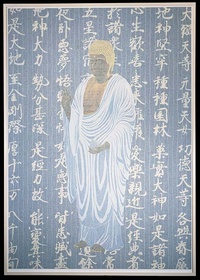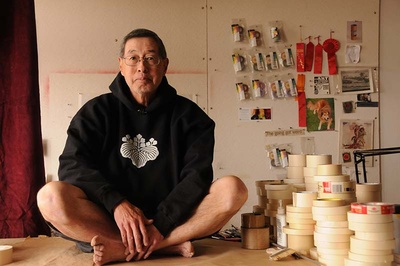To call Patrick Nagatani a photographer, or even a fine art photographer, seems like such a wan, inadequate description because his work—30 years’ worth of which will be displayed in two Los Angeles exhibits beginning this month—is so richly layered with cultural symbols, narratives, dreams and memories. He is a magician, shaman, set designer, and director who meticulously constructed images recall the fabulous imaginary worlds of Haruki Murakami or Gabriel Garcia Marquez, two of Nagatani’s favorite novelists.
Desire for Magic: Patrick Nagatani, at the Japanese American National Museum (JANM), and Then and Now, a group show of eight photographers active in Los Angeles in the late sixties and seventies, at dnj Gallery in Santa Monica, will both open on November 19. The JANM exhibition was created by the University of New Mexico’s University Art Museum, and corresponds with the publication of a lavish coffee-table book by the University Art Museum, Desire for Magic: Patrick Nagatani 1978-2008. (Nagatani taught photography at UNM for close to 20 years and still lives in New Mexico).
The dnj show is part of the sprawling multi-venue “Pacific Standard Time,” which celebrates the birth of the L.A. art scene.

Japanese Children’s Day Carp Banners, Paguate Village, Jackpile Mine Uranium Tailings, Laguna Pueblo Reservation, New Mexico, 1990, Chromogenic print. Courtesy of Patrick Nagatani.
The JANM exhibition, like the book, looks at seven major Nagatani projects that often overlapped during the 30-year-retrospective period. In an early 1983-1989 collaboration with painter Andrée Tracey, the two artists scoured L.A. thrift stores for props that they spray painted and hung in detailed, three-dimensional sets. The series of kinetic 24” x 20” Polaroid narratives they created capture split-second scenes of nuclear and earthquake apocalypse. Graphic and darkly humorous, they borrow from the languages of pop art and advertising, and, in their elaborate set design and dramatic tension, from Hollywood movies. (Nagatani once worked as a model maker for Hollywood sets.) The artist’s Japanese American roots are visible throughout his work; L.A.’s Little Tokyo, including the iconic Atomic Café, provides the backdrop for several photographs. Another disaster scenario, the 1985 work, “34th and Chambers,” set in a New York City subway station, reads today like a spooky forecast of future terrorist attacks.
Nagatani has said that by 1976, before he even entered UCLA’s master of fine arts program in photography, he had discarded the idea of “photographic truth,” and instead wanted to devote himself to what he calls “the façade of representation.” As did his teacher and mentor at UCLA, Robert Heinecken, he appropriates images and mixes mediums, drawing from his own Japanese American identity, history, and popular culture, always stretching the boundaries of photography to create gorgeous, daring works of art.
The nuclear threat hangs heavily over Nagatani’s work, in part because of New Mexico’s central role in the testing and development of atomic weapons. In a series titled “Nuclear Enchantment,” created between 1988 and 1993 in collaboration with poet Joel Weishaus, Nagatani visits nuclear test sites throughout the state. Here, his densely layered narratives in saturated, radioactive colors pay tribute to the state’s displaced Native American culture, and juxtapose images of Japanese tourists, children and Nagatani and his own family against nuclear missiles, monuments, and contaminated wastelands.
Again, recent events—this time the recent Fukushima earthquake and nuclear disaster—lend fresh relevance to Nagatani’s reminder of the danger that lurks beneath the optimistic language of science and progress. In one photograph of a nuclear weapons exhibit in the Bradbury Science Museum at Los Alamos National Laboratory, Nagatani superimposes the shadowy faces of Japanese children killed by American atomic bombs and labeled jars of their remains; another shot adopts the gorgeous hues and graphic stillness of a Hiroshige woodblock print, depicting snow falling on pine trees in the contaminated Mortandad Canyon. The simple title of the bleak landscape, “Bida Hi/Opposite Views: Navaho Tract Homes and Uranium Tailings,” is heartbreaking.
After these densely layered and heat-generating set pieces, the 1993-1995 series “Japanese American Concentration Camps” feels like an astringent slap in the face. Nagatani photographed the remains of the 10 prisons where 120,000 Japanese Americans were imprisoned by the U.S. government during World War II. His style is straightforward, and his landscapes unadorned.
Historian Jasmine Alinder, in her introduction to the series in Desire for Magic, notes that this “absence of overt manipulation…contributes to the photographs’ accessibility,” and writes that when they were shown at L.A.’s Japanese American Cultural and Community Center, former prisoners, some of whom probably had been reluctant to discuss this period of their lives before, used them as links to buried memories, telling stories and opening a dialogue that Sansei like Nagatani had been deprived of for most of their lives. Nagatani’s mother was sent to the Manzanar, California concentration camp, and his father was imprisoned in Jerome, Arkansas, yet they rarely spoke of their prison experiences.

Rohwer, Japanese-American Concentration Camp, Arkansas, August 28, 1993. Courtesy of Patrick Nagatani.
The stark landscapes, especially those photographed at Manzanar, can also be read as a reply to the iconic images that Ansel Adams shot at the prison camp. Instead of making the breathtaking Sierra Nevada the focal point, as Adams did in his 1943 photograph Winter Sunrise, Sierra Nevada from Lone Pine, California, Nagatani’s attention is focused on the architectural ruins of the camp and its cemetery, while the towering Sierra Nevada is relegated to the role of low-lying backdrop.
In the beautiful, sometimes surrealistic 1978-2007 series “Chromatherapy,” Nagatani the set designer and storyteller is back, using an ancient form of healing with colored light as a jumping off point to explore the properties of color, light, medical manipulation and healing of all sorts, including a reference to his own battle with cancer.
Nagatani’s most recent work is included in a series he began in 1982, “Tape-estries,” an astonishing, virtuosic and ethereal set of color print photographs of “paintings” he made using only masking tape. In his artist’s statement, Nagatani describes marathon, meditative taping sessions he likens to “chanting,” or “being in shape and running ten miles….Time passes and only my aching fingers and shoulders indicate how long I have been continuously painting with the tape. I relish the focus on details and to be lost in the quiet and minute parts of the whole.” Fittingly, his subject matter here is his most spiritual: a French cathedral, bodhisattvas, Hindu gods, and—granted almost god-like status in Nagatani’s pantheon—a healer and a magician.
Summing up both his “Tape-estries” and his entire of work so far, Nagatani writes, “I want magic in my life and work. Beauty is important.”
* * *
Desire for Magic: Patrick Nagatani
November 19, 2011 – January 14, 2012
Japanese American National Museum
100 North Central Avenue
Los Angeles, CA 90012
213.625.0414
Then and Now
November 19, 2011 – January 7, 2012
dnj Gallery
Bergamot Station
2525 Michigan Ave. Ste J1
Santa Monica, CA 90404
310.315.3551
To read more about Patrick Nagatani >>
© 2011 Nancy Matsumoto








